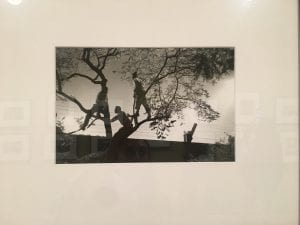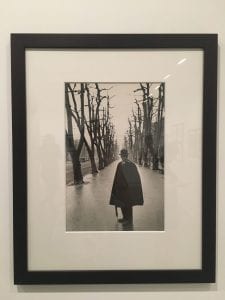This photograph belongs in Cartier-Bresson’s collection of “the decisive moment”. I was immediately drawn to this image upon entering the gallery because of its clear, structured lines and its curious narrative. Both the line on the wall to the left and the line created by the canon force viewers to look at the child, which helps create an interesting narrative. This photograph was captured in Italy during the 1930s, when Italy was under strict, fascist control by Mussolini. The lines in the image are straight, rigid, and firm, a perfect visual representation for the way the country was being controlled. The lines lead us towards the child: a product of this authoritarian world. Mussolini insisted that all boys be warriors; he wanted all males to act as fascist soldiers, and all women to bear more than five children. The fact that the child stands next to a canon introduces the idea that he is being forced into violence. The fact that he is only a silhouette, not an individual, refers to the quantity of young children expected to act violently. I believe that featuring this one child, instead of many, is very valuable to the photograph’s composition and story. The child can represent the masses, but there is a beauty to his solitude and it creates an interesting juxtaposition between this singular child vs the expectation that women must bear multiple children.
This photograph by Elliott Erwitt captured my attention because it reminded me of Kara Walker’s work. Here, he features three African American silhouettes, as Walker often does. The photograph is incredibly successful, which can be attributed to its composition, lines, shapes, contrast, and concept. The three subjects are placed according to the rule of thirds, and the fact that there are three subjects helps create a comfortable and aesthetically pleasing picture. The eye first moves to the silhouettes, but the lines don’t allow our eyes to linger there. In fact, the lines encourage viewers to travel through the photograph (from left to right); the shapes created by the tree and the subjects serve as a final resting spot for viewers’ eyes. The triangular shapes, the repetition of shape and form, and the fact that the subjects are looking outwards draws viewers into the photograph and leaves us imagining what the subjects could be looking at. The juxtaposition between the lights and darks in the photograph may relate to the political and social struggles of that time. Erwitt photographed his subjects during the peak of the civil rights movement, so by having his subjects against such a light background he is emphasizing the differences between races. In addition, the high contrast allows viewers only to see the subjects’ silhouettes. There are no distinguishing features amongst them and there is no sense of individuality. The fact that the subjects also look “fenced in” could be relevant to the struggles of that time: African Americans were segregated, they were separated from the rest of society, they did not have equal freedoms. Therefore, the fence may represent their struggles and sense of confinement.
What interests me most about this photograph is the fact that the subject is slightly uncentered, and a ring of light surrounds his head. When this was photographed, France was in the middle of the Great Depression, with unemployment peaking. The ring of light around the subjects’ head may represent the hope for those who were affected. Meanwhile, the fruitless trees represent France’s barren soil; France is struggling financially and is unable to provide for its people, just as the soil is unable to provide enough nutrients for the trees to flourish. The subject in the photograph is wearing dark colors to emphasize the uncertainty many French people are facing. This darkness is reinforced by the light background, creating a complex yet appealing combination of lights and darks. In addition, the movement in this photograph is striking: the man is prominent in the picture and moves your gaze upwards, towards the lifeless trees.



Leave a comment